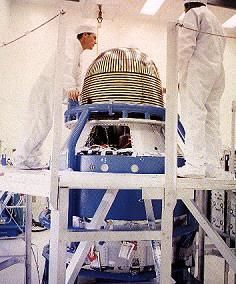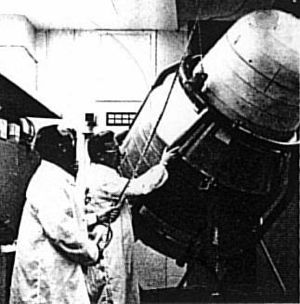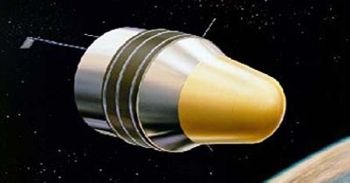
Home - Search - Browse - Alphabetic Index: 0- 1- 2- 3- 4- 5- 6- 7- 8- 9
A- B- C- D- E- F- G- H- I- J- K- L- M- N- O- P- Q- R- S- T- U- V- W- X- Y- Z
Biosatellite
 Biosat 3 Credit: NASA |
AKA: Biosat. Status: Operational 1966. First Launch: 1966-12-14. Last Launch: 1969-06-29. Number: 3 . Gross mass: 542 kg (1,194 lb).
It was equipped with a re-entry capsule to return the test plants and animals to earth after a month in low earth orbit. Management and technical problems resulted in the third satellite taking a monkey into orbit only three weeks before the first American human being set foot on the moon. The mission was terminated after only nine days and the monkey died soon after return to earth. The project became the subject of enormous derision in the press, and three further planned missions were canceled.
More at: Biosatellite.
Family: Biology. Country: USA. Engines: Star 12. Launch Vehicles: Thor, Delta, Thor Delta G, Thor Delta N. Launch Sites: Cape Canaveral, Cape Canaveral LC17B, Cape Canaveral LC17A. Agency: NASA. Bibliography: 2, 279, 297, 6, 6390, 12158.
 | Biosat 1 Credit: NASA |
 | Biosatellite 1 Credit: Manufacturer Image |
1966 December 14 - . 19:20 GMT - . Launch Site: Cape Canaveral. Launch Complex: Cape Canaveral LC17A. LV Family: Thor. Launch Vehicle: Thor Delta G.
- Biosatellite 1 - .
Payload: Biosat 1. Mass: 425 kg (936 lb). Nation: USA.
Agency: NASA Ames.
Class: Biology.
Type: Biology satellite. Spacecraft: Biosatellite.
Decay Date: 1967-02-15 . USAF Sat Cat: 2631 . COSPAR: 1966-114C. Apogee: 309 km (192 mi). Perigee: 295 km (183 mi). Inclination: 33.50 deg. Period: 90.40 min.
Reentry into the Earth's atmosphere was not achieved because the retrorocket failed to ignite. The biosatellite was never recovered. Although the scientific objectives of the mission were not accomplished, the Biosatellite I experience provided technical confidence in the program because of excellent performance in most other areas.
1967 September 7 - . 22:04 GMT - . Launch Site: Cape Canaveral. Launch Complex: Cape Canaveral LC17B. LV Family: Thor. Launch Vehicle: Thor Delta G.
- Biosatellite 2 - .
Payload: Biosat 2. Mass: 507 kg (1,117 lb). Nation: USA.
Agency: NASA Ames.
Class: Biology.
Type: Biology satellite. Spacecraft: Biosatellite.
Decay Date: 1967-09-15 . USAF Sat Cat: 2935 . COSPAR: 1967-083A. Apogee: 318 km (197 mi). Perigee: 297 km (184 mi). Inclination: 33.50 deg. Period: 90.70 min.
Biological capsule recovered. The scientific payload, consisting of 13 select biology and radiation experiments, was exposed to microgravity during 45 hours of Earth-orbital flight. Experimental biology packages on the spacecraft contained a variety of specimens, including insects, frog eggs, microorganisms and plants. The planned three-day mission was recalled early because of the threat of a tropical storm in the recovery area, and because of a communication problem between the spacecraft and the tracking systems. The primary objective of the Biosatellite II mission was to determine if organisms were more, or less, sensitive to ionizing radiation in microgravity than on Earth. To study this question, an artificial source of radiation was supplied to a group of experiments mounted in the forward part of the spacecraft.
1969 June 29 - . 03:15 GMT - . Launch Site: Cape Canaveral. Launch Complex: Cape Canaveral LC17A. LV Family: Thor. Launch Vehicle: Thor Delta N.
- Biosatellite 3 - .
Payload: Biosat 3. Mass: 695 kg (1,532 lb). Nation: USA.
Agency: NASA Ames.
Class: Biology.
Type: Biology satellite. Spacecraft: Biosatellite.
Decay Date: 1970-01-20 . USAF Sat Cat: 4000 . COSPAR: 1969-056A. Apogee: 374 km (232 mi). Perigee: 363 km (225 mi). Inclination: 33.50 deg. Period: 92.00 min.
Biological capsule reentered 7/7/69. The intent had been to fly a 6 kg male pig-tailed monkey (Macaca nemestrina) named Bonnie in Earth-orbit for 30 days. However, after only 8.8 days in orbit, the mission was terminated because of the subject's deteriorating health. High development costs were a strong incentive for maximising the scientific return from the mission. Because of this, the scientific goals had become exceedingly ambitious over time, and a great many measurements were conducted on the single research subject flown. Although the mission was highly successful from a technical standpoint, the science results were apparently compromised. Additional Details: here....
Back to top of page
Home - Search - Browse - Alphabetic Index: 0- 1- 2- 3- 4- 5- 6- 7- 8- 9
A- B- C- D- E- F- G- H- I- J- K- L- M- N- O- P- Q- R- S- T- U- V- W- X- Y- Z
© 1997-2019 Mark Wade - Contact
© / Conditions for Use